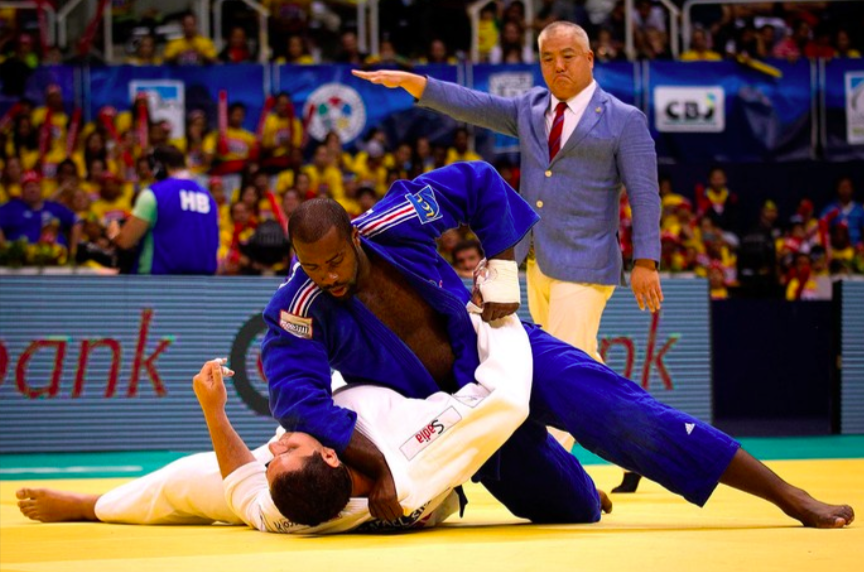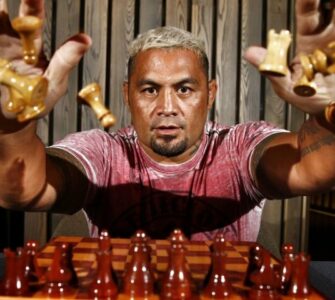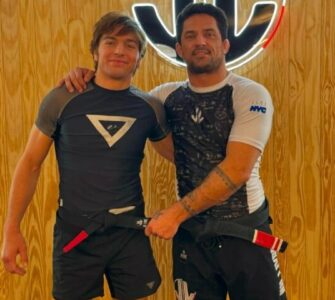Guest post by Neil Adams MBE, Judo World Champion, plus silver medals in the 1980 and 1984 Summer Olympic Games and the 1983 Judo World Championships. Adams was also five-time European Champion. On 20 September 2008 he was promoted to 8th Dan at the age of 49. He is known for his ground game (ne waza) and his armbar.
Adams has released a highly detailed new series of Judo instructional ‘Essential Judo‘ .
In this article, we are going to look at how you can defeat Judo players that dominate by throwing the big right arm over and controlling the opponent. Teddy Riner is a classic example of this and as such this article is a look at how you can deal with and defeat this type of Judoka.
Teddy Riner is the world’s most dominant Judo player. An Olympic champion and eight times World Champion. Standing 6ft 8 inches tall and weighing in 128 kilos, let me be clear, he is never going to be easy to beat. However, there are ways to defeat Judoka who dominate through their grips, at the least making it more difficult for them.
Case Study 1: Teddy Riner in the Olympics
Riner is the current Olympic Champion. Born on 7th April 1989 and became the Olympic Champion of the Men’s heavyweight division that is 100+ Kilos. At the London 2012 Olympics, he reached the final to take on Alexander Mikhaylin. Let us relive that huge matchup in this video;
Riner has enjoyed unparalleled success but his recipe is clear for all to see, and it revolves largely around his grip fighting.
Kumikata: The Grip Fighting of Judo
Teddy has been dominating fighters who are not as skilled as himself in the art of Kumikata. His tactics are simple, straight to the point and effective.
Teddy Riner will aim to catch the sleeve hand of his opponent first, and then he throws the big right hand over the top of his opponent in order to dominate his opponent’s head. As we will see in this next highlight video, this happens often which results in scoring Ippon. Once he gets his grips, the opponents fall.
Riner’s gripping can also be seen in this video as well, just look at the slow motion version of this throw;
A classic example of this in action can also be seen in this next contest between Teddy Riner and Adam Okruashvili of Georgia. In the first few minutes you will see Riner looking for his sleeve grip, once he gets it, he then throws the big right hand over and then he launches his attack.
So how would someone go about beating someone with the big Over Hand grip?
In my opinion, everyone is so focused on the big right hand and how it works that they are failing to understand the purpose and danger of the sleeve hand.
Remember, what happens is that Tori catches the sleeve hand first and then they go over the shoulder with the big right hand in order to control the head.
Therefore, top priority should be to stop the sleeve being dominated either by being first with the grip or by changing body angles to prevent them catching the sleeve.
Good body positioning when coming together is very important to prevent the sleeve being taken. It should be angled away rather than face on to the opponent. You can only run for so long however, and so we need to practice applying the grip first. At the same time making sure that your body angle, or lack of, does not make it easy for your opponent to take your sleeve. You need to protect it.
The last person to beat Teddy Riner was Daiki Kamikawa at the 2010 World Judo Championships. After Riner had won the heavyweight division, he then lost in the open weight in a very close match to Kamikawa.
For me this showed a chink in Riner’s armour and really demonstrated how with different tactics you can upset the balance of a contest.
Kamikawa won by not bothering too much about the big right hand coming over the top. He allowed Riner to throw that arm over and take a grip. It didn’t phase him because as it came over he attacked with Sasai Tsurikomi ashi attacking the back leg of Riner and using Riner’s own power and momentum against himself. It caused Riner so many problems.
The main point in this is that Kamikawa let the hand come over; his focus wasn’t the right hand. Instead, he was more concerned about finding ways to attack effectively, even with that right-hand coming over the top. Kamikawa made sure he wasn’t there to recieve the right hand. He was already in motion for his ashiwaza.
Anyone thinking about how to beat Riner or other tall rangy fighters who use the same type of game plan needs to watch the video of that match (sorry it’s not the best quality) and look at the tactics that Kamikawa employed.
This same principle applies to many of the top Judoka on the circuit today. Many have different styles of gripping that control their opponents through their unique grips, but the first hand gripping plays a key part in the contest. The most obvious hand might not be the most dangerous and often it’s not. One could call it a form of “slight of hand.”
Look at some of our successful maki komi fighters at the moment, fighters like Lippertiliani of Georgia, Kayla Harrison of the USA and Joo of Hungary. Where does their power start and finish? It is the first hand that lands on their opponents. The free hand is the one that gathers speed and power but only after the first one grips first. The Mongolians and their successfull hugging Ko soto garis. They all start their throws with the first hand that lands on their opponents.Their free hand and body follow shortly after and at pace!
Conclusion
This article was all about showcasing how a person could defeat a player such as Teddy Riner. The type of Judoka, who uses the same style of Judo where they throw the big hand over the shoulder for the grip.
The key is to kill that first hand!
The one that is after breaking your balance, be it on the sleeve or lapel.
Think about how to stop the first hand getting a grip and then learn to make your attacks. Or stop worrying about that big hand coming over and learn to be ready to attack from that position.
I hope this article will help you or any players out there against these types of opponent or at least get you to think about the underlying threat that isn’t always that obvious.



















